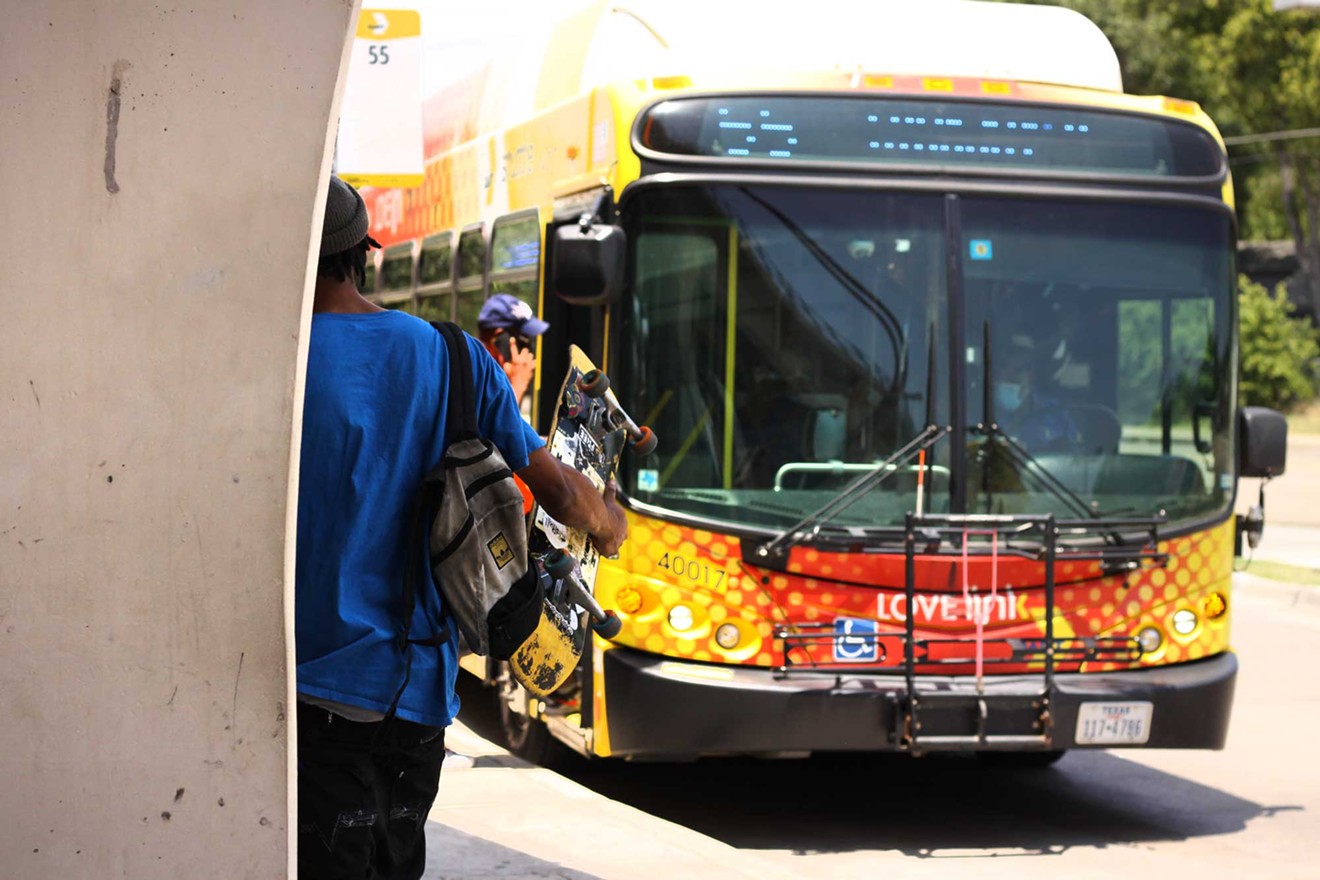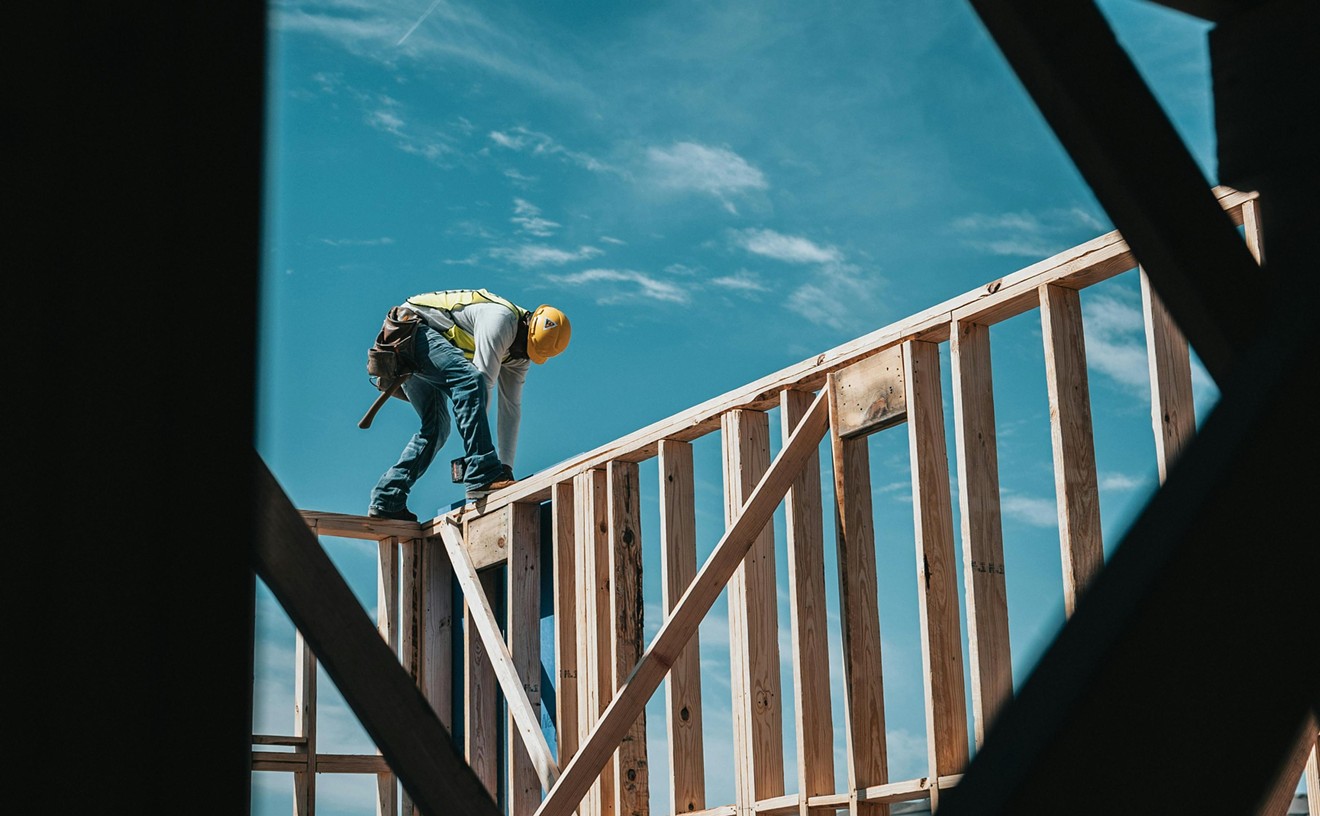The Dallas Area Rapid Transit (DART) board had contracted with Walker and his firm to devise a new plan for the city’s bus system, and he was well suited for the job: He had over 25 years of experience in public transit planning in cities on several continents.
He laid out some of the tough questions the city would have to ask itself before it could have a successful transit system. Walker said there’s a wall around people’s lives that’s defined by the limits of where they can get to in a reasonable amount of time. That wall can be expanded with public transit, and that can make people freer, Walker said.
“Because what is freedom but the presence of actual options?” Walker said. "The presence of actual choices you can make. You are not free as a shopper if you can only get to one grocery store, especially a grocery store that only sells one kind of milk.” (That is especially true in poorer parts of the city considered food deserts.)
To replan Dallas’ transit system, DART had to choose between two goals: increased ridership or increased coverage. DART can make public transit more useful to the largest number of people, or make it accessible for everyone. There are upsides and downsides to each approach. Overall coverage would be more equitable. Focusing on ridership could support redevelopment and have more environmental benefits.
Everyone wants both, but that’s not how public transit works. DART had to make a choice.
A lot has happened since then. The following month, COVID-19 lockdowns shuttered much of the world, closing public transit off to many. The pandemic slammed an already under-resourced and underfunded DART, leading to cuts in staff, the bulk of which were seen in the bus and rail departments. In July 2020, DART said it would face a $1 billion negative hit to its revenue over the next two decades because of the pandemic."Because what is freedom but the presence of actual options?" - Jarrett Walker
tweet this
Despite the economic turmoil brought on by COVID-19 and changes in the industry, DART board member Michele Wong Krause still spoke idealistically about the bus service in July 2020, saying she believed it would remain the backbone of the city’s transit system for the foreseeable future.
The reality on the ground is a little darker. Taking public transportation can feel like you’re playing connect the dots. You take a shuttle or walk to your nearest bus stop. If you’re lucky, maybe that bus will take you straight to where you need to go. A lot of times, though, you’ll have to hop on another bus or train, or several — a few more dots to connect to get to your final destination.
Sitting at one of the DART stations, you might see trash scattered, a fight nearly breaking out behind you, and maybe a man pouring Steel Reserve 211 into a Big Gulp cup to quench his thirst as he waits for his next trek. You may even spot someone using drugs or suffering a mental health crisis. It’s not always comfortable. It all might be a little more tolerable if the transit system could reliably get you where you need to go on time. Lately, the buses haven’t been able to do this for everyone.
**

Artis Jarvis works as a customer service agent at Love Field and finds service to be unpredictable at times.
Jacob Vaughn
Artis Jarvis, 59, works at Dallas Love Field Airport as a customer service agent. Waiting for his ride at the Inwood/Love Field DART station, Jarvis said it’s hard to be mad about public transit when gas is so expensive, but he still had some complaints. It’s not all that different from what others are saying. He doesn’t always know if and when his bus will show up or if he’ll get to work on time.
Jarvis said he sometimes shows up late to work because the buses are running behind schedule. “People are missing work,” Jarvis said. “I pay for a monthly bus pass, so I should have a way to work every morning.” That’s not always the case.
His bosses cut him some slack when delays leave him running late. They know there’s not a lot he can do about it. Other employers aren’t always so understanding.
Timothy Reddick, 62, lives near Love Field but works in Oak Cliff. He’s worked at a company in the area called Pallet Logistics of America for about four years. For the last two years, he was able to get to and from work and around the city without a car with relative ease, or as much ease as Dallas’ public transit can offer. He could get to work on time and go grocery shopping without having to get a friend to give him a ride.
But since DART redrew its bus routes, he’s been working to get his driver’s license and a car so he doesn’t have to rely on public transit anymore. Before the routes were redrawn, taking the bus wasn’t exactly a cakewalk for Reddick. He would still have to take three separate buses and sometimes hop on the train to get to his destination. This meant most times he would get off work around 11:30 p.m. and make it home by around 1 a.m. But, it was pretty much a straight shot, the buses were consistently on time, and his stop was just around the corner from his house. “It was simple,” he said.
He just became a team lead recently where he works, but now he’s worried about losing his job because the buses can’t get him there on time. “I’ll be tired by the time I get to work,” he said.
These days, he has to walk up to 3 miles to his bus stop. GoLink, a shuttle service provided by DART, is supposed to make some of that trek a little easier. But, he said, this service isn’t reliable either. “When you call GoLink, half the time they cancel the ride,” Reddick said. “Then, you have to call back and try to get another ride. Then you have to wait on that. Then, you have to pay a double fare because you have to pay $2.50 for the GoLink. Then you have to pay to get on the train or the bus.”
So, it’s less convenient and takes a toll on his wallet. If the GoLink cancels on him, DART will usually send him an Uber. By then, though, he’s already behind schedule.
At night, he catches a ride to the train station, where he doesn’t always feel all that safe. “The trains are dangerous now, especially at night,” Reddick said. “They don’t have no security on that train at night time, and people get on there and act a fool. Half of them … on there [are] drunk, wanting to fight, looking at you crazy and everything else.”
Inconvenience or not, he has to take the red line downtown to get on the 207 bus. That bus drops him off about a half-hour's walk from his home. That walk is virtually his only option as the GoLink shuttles don’t operate late at night. “Sometimes my legs don’t feel like walking,” he said. Worse still, the city’s streets aren’t the safest either."People are missing work." - Artis Jarvis, commuter
tweet this
These days, he can get home around 1:30 a.m. A few hours later, he’ll be up to do it all over again.
It’s only a 30-minute difference from when he used to get home, but there’s a lot more struggle in that time now. On top of that, Reddick said, the buses are less consistent. “Now, you don’t know what time the bus is going to come or not,” he said.
One day, he waited about an hour and a half for bus 207, and DART ended up having to send him another ride. Luckily, that day he just needed to go to the bank. Asked if his bosses would be understanding if the bus made him late to work, Reddick said, “They don’t care about that. They get mad. They want you there on time.”
There have been meetings for riders to give their input, but Reddick said he’s usually at work during when they’re held. If he could, he’d tell DART to change his route back to the way it used to be.
Hosanna Yemiru was appointed to the DART board last August, around the time the new routes were being approved. Yemiru has been a pretty consistent DART user throughout her life. Growing up, she’d use DART to get to school and to work. Her commute was more of a straight shot than Reddick’s, but she’d still run into issues.
“Sometimes I would have no idea when the bus would show up,” Yemiru said. This was before the new routes were implemented. Eventually, the cost for DART riders started to rise. The amount of money she would have to pay to ride DART kept going up by the year. “It was still kind of the only option I had. It was very difficult to pay for transit,” she said.
She joined the DART board just as it was getting ready to approve the new bus system. “In general, the point was you wanted to have a system that was going to be faster and easier to use and it was going to be providing this really good balance between coverage and consistency,” Yemiru explained. For a long time, DART has tried to cover as much area as possible, “Sometimes at the expense of frequent service,” she said.
The relaunch was able to get that balance to an extent, but staying budget neutral has made it difficult, Yemiru said.
**
Remember when Walker said DART would have to choose between increased ridership and increased coverage? Well, DART wanted a little of both.
In November 2020, DART’s board of directors decided they wanted to go with a hybrid model for the new bus system. The idea was 70-75% of DART’s resources would go toward ridership-oriented services, while the remaining 25-30% would go toward coverage-related service.
They expected initial complaints from regular riders, Yemiru said. “There’s always that learning curve,” she said. “So, of course the first round of complaints were like ‘What is going on?’”
Then, the complaints started to sound much like the ones they were trying to fix with the new routes. People were missing their rides because buses were too early, too late, or not showing up at all. The walk to the bus stops grew for many. The shuttle service meant to make the walk easier wasn’t reliable. Riders weren’t getting where they needed to be when they needed to be there.
It turns out DART had a decent game plan, just not enough people to help execute it. “We’re having a retention problem,” Yemiru said. “We’re hiring a bunch of people, but we’re losing a lot of people.”
Why? Put simply, “being a bus operator is hard,” Yemiru said. Plus, a transportation job in the private sector often pays more and provides better benefits.
If you asked random people at any given DART station what they think of the new routes, a handful might say it’s changed their commute for the worse. Another handful may say it took time to adapt to the new routes, but overall, they feel the rides are more frequent and their commute is easier.
If you ask the bus drivers, they may tell you the increased frequency is crushing them, mostly because they don’t have enough people. “They bit off more than they could chew as far as upping the schedule,” one driver said. “They want buses stopping every 15 minutes. We don’t have the manpower for that.”
DART recently made adjustments to a few of the bus routes to account for the shorthanded system. The wait times at bus stops may be a little longer under the adjustments, but they should also be more reliable.
At a special meeting of the Dallas City Council’s Transportation and Infrastructure Committee, Rob Smith, DART’s vice president of service planning and scheduling, explained the changes meant to address their driver shortage.
He said the bus route redesign rolled out this year was “the most significant change to bus service in DART’s history.” The work on the redesign began in October 2019, the point being to improve access and coverage. That meant increasing the number of jobs accessible by transit within an hour of travel, and making it more accessible to people across every demographic and socioeconomic group."We’ve had missed trips throughout the bus system." - Rob Smith, DART
tweet this
“In the process of doing all of that and seeing it in operation since January, we’ve learned a number of things along the way,” he said. “What we did not anticipate, however, when we kicked off this process, was the impact of operator shortages on what we have done.”
Based on feedback they’ve received in that time, they made some adjustments and implemented them on June 13. The majority of those adjustments, Smith said, “are aimed at bus operator shortages.”
“Similar to what’s happened to many transit agencies around the country, DART has faced some real labor shortages over the past couple of years, and we didn’t anticipate when we designed the network and went back to full service levels that we would see the impact we ended up seeing,” Smith said.
“We’ve had missed trips throughout the bus system,” he added. “And the goal of the changes we’ve made are to help temporarily deal with those situations while we are hiring operators to fill in the gaps and then restore regular service as soon as possible.”
The changes they made on June 13 affected 31 bus routes, about a third of the bus system. That increased some service times. For example, the buses meant to come every 15 minutes will now be there closer to every 20. Some 20-minute waits could stretch to half an hour in the middle of the day and early evening.
Rosa Medina-Cristobal, DART’s vice president of human resources, said her department is at work trying to lure new bus drivers and keep the ones they have.
Medina-Cristobal said DART increased operator pay from just over $17 an hour to $21.13. That’s after a recent cost of living adjustment. They also did a survey to see why they were losing operators. The survey found drivers are leaving DART for various reasons: a higher paying job, wanting more workforce development opportunities and because they don’t like their supervisors.
Many other employers were offering sign-on and referral bonuses, so DART rolled out its own on April 1. In the first week, 100 applications poured in.
The pandemic halted a lot of DART’s hiring processes. They’ve beefed up hiring since then, but DART is still short 163 drivers, Medina-Cristobal said. Getting people hired is the easy part. The tough part is keeping drivers there. “I’m not worried about the hiring part. It’s the hiring part plus attrition,” Medina-Cristobal said. “Let’s say you hire 20 people every two weeks, but you lose just as many in two weeks. It’s the net gain that I’m concerned about.”
**

Chris Tinnon has mixed feelings about the DART changes because some times the frequency of busses help, but its easy to get lost on a wrong bus route.
Jacob Vaughn
Tinnon has been riding the DART buses since he was a teenager. Before DART’s big bus route change this year, he said people would complain about missed rides or not being able to trust that they’ll get anywhere on time. It’s a problem that persists today with the new routes, but, Tinnon said, the increased frequency makes it easier to deal with.
“I’ve got mixed feelings about it,” he said. “Having the buses come back to back like that, it’s much more convenient. But if you don’t know where you’re going or know what bus runs in that area, you get lost. So, you have more people complaining about the getting lost part than the convenience part.”
He said it’s because the routes have changed so much. Tinnon gave an example. The 526 bus used to be able to take him to Empire Central, Tinnon said. Now, it’s bus 222 that takes him there. If people don’t know that, Tinnon said, “They’ll get mad and confused and be like, ‘This is fucked up because I don’t know where I’m going.’”
Since DART rolled out the recent changes in June, Tinnon said, his buses have been more reliable. More adjustments could come.
We asked DART how many changes can be implemented to the new system before it begins to look like the old one. DART officials are asking themselves the same question, said Gordon Shattles, the agency’s spokesperson. Still, the recent changes don’t affect the overall intent or structure of the new system. They’re keeping a close eye to try to ensure DART doesn’t undo all the work of the new design.
But this is apparently just the beginning of the changes. “The new bus network is the starting point for future anticipated changes in the system,” Shattles said. “DART and the Jarrett Walker team will soon start work to develop a plan for future service changes in the coming years.”"The new bus network is the starting point for future anticipated changes in the system." - Gordon Shattles, DART
tweet this
The reliability issues they’ll face in the meantime, Shattles said, “are a direct consequence of labor shortages plaguing DART and other transit operators and companies around the country.”
“DART has been hiring bus operators and is now aggressively ramping up hiring, but attrition rates are far beyond anticipated levels and have left us short of staffing requirements for bus service,” Shattles said “The temporary service adjustments implemented June 13 aim to reduce the number of missed trips while the more aggressive hiring efforts fill staffing gaps. Our goal is to resume normal service levels on the affected routes as soon as possible.”
Rider Timothy Reddick isn’t waiting around to see how it all goes. He’s working on getting his car so he can ditch Dallas’ public transit all together. “I’ve got to get a car now because I can’t find nobody sometimes to take me to the grocery store and bring me back,” he said. “I used to do that, but I can’t do that any more. So, I’ve got to get me a car to get to work, to get to the grocery store and stuff like that.”
Maybe then, he’ll be a little freer.













